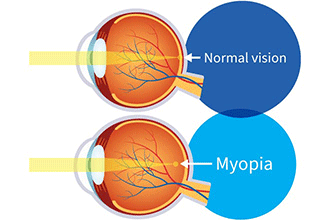What does it mean to be shortsighted?

What is shortsightedness?
“Short-sighted” is a term used to describe nearsightedness or myopia. Being shortsighted means you can see objects that are close to you clearly, but distant objects appear blurry. It can occur if the eyeball is too long or the cornea is too steeply curved.
Shortsightedness can be corrected with eyeglasses, contact lenses or refractive eye surgery.
What makes someone shortsighted?
Your eyeball shape determines whether you are shortsighted or not.

Myopia occurs when light focuses too far in front of the retina.
On average, the dimensions of a typical eye are 0.95 inches tall, 0.93 inches wide, and 0.87 to 0.98 inches from front to back. Someone who is shortsighted has a longer eyeball from front to back.
When an eye has typical dimensions, light is able to enter it and focus directly onto the retina at the back of the eye. The retina uses light to create signals that are sent to the brain and made into images. So, the better lighting the retina has, the clearer an image will appear.
Because an eyeball with shortsightedness is longer than it should be, light lands in front of the retina and causes objects at a distance to appear blurry while close-up objects remain sharp.
Increase in people who are shortsighted
In March 2015, the World Health Organization published the percentage of the world’s population that had myopia. The numbers showed percentages for every 10 years, starting in the year 2000.
Between 2000 and 2010, the number of people with myopia went from 22% to 28%. Though the study projected an increase to 33% by the year 2020, the actual number is higher.
Studies show that pandemic-related confinement has affected myopia development in children. One study noted a significant increase in six-year-olds with myopia between 2015 and 2020.
In 2015, only 3.5% of six-year-olds had myopia. In 2019, the number rose to 5.7%. However, between 2019 and 2020, the percentage shot up to 21.5% — an increase of almost 400% from the previous year.
At this rate, the World Health Organization predicts 40% of the world population will be shortsighted by 2030, and that over half the global population will be affected by 2050.
SEE RELATED: 5 ways the coronavirus pandemic may be affecting your child’s eyesight
Slowing myopia progression in shortsighted people
There is no cure yet for shortsightedness. But eye doctors can prescribe different treatments to keep myopia from getting worse. This is known as myopia control.
Methods to slow myopia progression include:
To learn more about myopia control for yourself or your child, schedule an appointment with an eye doctor to discuss treatment options.
READ MORE: Myopia: Frequently Asked Questions
The impact of myopia and high myopia. World Health Organization. March 2015.
Progression of myopia in school-aged children after COVID-19 home confinement. Jama Ophthalmology. January 2021.
Page published on Thursday, February 24, 2022
Medically reviewed on Wednesday, February 9, 2022






